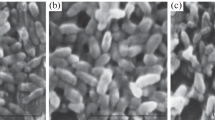Abstract
Many simple gliding bacteria contain significant quantities of phosphate-free, sulfur-containing lipids (sulfonolipids; N-acylamino-3-hydroxyisoheptadecane-1-sulfonic acids, or N-acyl capnines) that recently were shown to function in the ability of Cytophaga johnsonae to migrate over solid surfaces. Reported here is the synthesis, by surface-grown Cytophaga johnsonae cells, of two additional sulfonolipids not present in cells grown in liquid media. These newly characterized sulfonolipids are more polar than the N-acylcapnines characteristic of liquid grown cells. Acid methanolysis of the sulfonolipids revealed that the aminosulfonate capnine was common to all, thus indicating that the chemical differences in the compounds resided in their N-fatty acyl groups, and not in the aminosulfonate moiety. Instead of the non-hydroxy and 3-hydroxy fatty acyl moieties present in sulfonolipids of liquid-grown cells, one new sulfonolipid contained a 2-hydroxy, branched C15 fatty acid, while the other contained a 2,3-dihydroxy, isobranched C16 fatty acid, as indicated by gas chromatographic and mass spectrometric analyses. Although the structure of sulfonolipids thus varies between surface- and liquid-grown cells, no difference was found between the total quantity of sulfonolipids present under either of these conditions. The surface-dependent synthesis of these more polar N-acyl-aminosulfonates ceased immediately when surface-grown populations were suspended in broth. The ability of Cytophaga johnsonae to synthesize these compounds in response to a solid surface may be significant in relation to the organism's ability to migrate over such surfaces; it is one of few instances where a physical interaction of the cell surface has been shown to influence the molecular composition of a prokaryote.
Similar content being viewed by others
Abbreviations
- LTY:
-
tryptone yeast extract medium
- TLC:
-
thin layer chromatography
- FAME:
-
fatty acid methyl ester
- ECL:
-
equivalent chain length
- T r :
-
retention time
- TMS:
-
trimethylsilyl
- TFA:
-
trifluoroacetyl
References
Abbanat DR, Leadbetter ER, Godchaux W, Escher A (1986) Sulphonolipids are determinants of gliding motility. Nature (Lond) 324:367–369
Belas R, Simon M, Silverman M (1986) Regulation of lateral flagella gene transcription in Vibrio parahaemolyticus. J Bacteriol 167:210–218
De Boer WE, Golten C, Scheffers WA (1975) Effects of some chemical factors on flagellation and swarming of Vibrio alginolyticus. Antonie van Leeuwenhoek J Microbiol Serol 41:385–403
Dworkin M, Keller KH, Weisberg D (1983) Experimental observations consistent with a surface tension model of gliding motility of Myxococcus xanthus. J Bacteriol 155:1367–1371
Fautz E, Rosenfelder G, Grotjahn L (1979) Iso-branched 2- and 3-hydroxy fatty acids are characteristic lipid constituents of some gliding bacteria. J Bacteriol 140:852–858
Godchaux W, Leadbetter ER (1980) Capnocytophaga spp. contain sulfonolipids that are novel in prokaryotes. J Bacteriol 144:592–602
Godchaux W, Leadbetter ER (1983a) Unusual sulfonolipids are characteristic of the Cytophaga-Flexibacter group. J Bacteriol 153:1238–1246
Godchaux W, Leadbetter ER (1983b) Purification of the N-acylaminosulfonates, unusual lipids of gliding bacteria. J Microbiol Meth 1:41–51
Godchaux W, Leadbetter ER (1984) Sulfonolipids of gliding bacteria. Structure of the N-acylaminosulfonates. J Biol Chem 259:2982–2990
Henrichsen J (1972) Bacterial surface translocation: a survey and a classification. Bacteriol Rev 36:478–503
Kates M (1972) Techniques of lipidology. In: Work TS, Work E (eds) Laboratory techniques in biochemistry and molecular biology, vol 3. Elsevier North-Holland, Amsterdam, pp 269–510
Keller KH, Grady M, Dworkin M (1983) Surface tension gradients: feasible model for gliding motility of Myxococcus xanthus. J Bacteriol 155:1358–1366
Mayberry WR (1980) Hydroxy fatty acids in Bacteroides species: d-(-)-3-hydroxy-15-methylhexadecanoate and its homology. J Bacteriol 143:582–587
Mayberry WR (1981) Dihydroxy and monohydroxy fatty acids in Legionella pneumophila. J Bacteriol 147:373–381
Orndorff PE, Dworkin M (1982) Synthesis of several membrane proteins during developmental aggregation in Myxococcus xanthus. J Bacteriol 149:29–39
Wolkin RH, Pate JL (1985) Selection for nonadherent or nonhydrophobic mutants co-selects for nonspreading mutants of Cytophaga johnsonae and other gliding bacteria. J Gen Microbiol 131:737–750
Author information
Authors and Affiliations
Rights and permissions
About this article
Cite this article
Abbanat, D.R., Godchaux, W. & Leadbetter, E.R. Surface-induced synthesis of new sulfonolipids in the gliding bacterium Cytophaga johnsonae . Arch Microbiol 149, 358–364 (1988). https://doi.org/10.1007/BF00411656
Received:
Accepted:
Issue Date:
DOI: https://doi.org/10.1007/BF00411656




